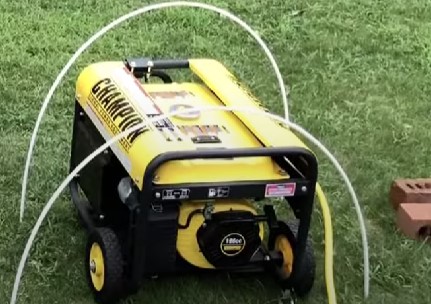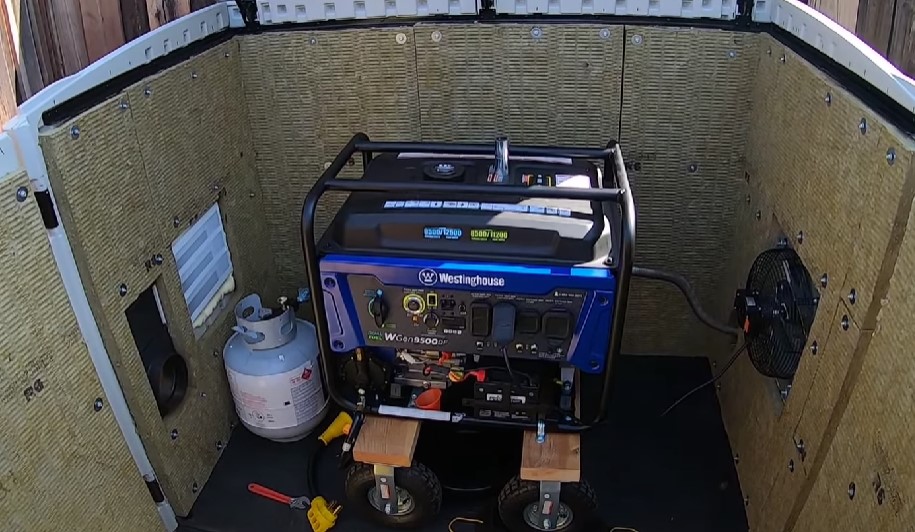The efficiency, safety, and longevity of generators greatly depend on their storage conditions. Moreover, generators are expensive. So, you should take care of your portable generator to use anytime.
In this article, we will cover everything related to portable generator storage. without further ado, let’s get started.
where to store generator when not in use?
When not in use, a generator should be stored in a location that is dry, cool, well-ventilated, and safe from extreme weather conditions. It’s also crucial to choose a location that is readily accessible for routine maintenance and quick use in case of a power outage. Here are a few options:
Garage or Shed
These are common choices because they typically provide protection from weather and temperature fluctuations. They’re often easily accessible. Ensure that these areas are well-ventilated and that there are no flammable substances around. Never run your generator inside these enclosed spaces because of carbon monoxide risks.
Outbuildings or Barns
If you have one on your property, an outbuilding or barn can be an ideal storage place. They usually offer ample ventilation and protect against weather elements.
Basement
A dry, ventilated basement can serve as a storage location. However, basements often have higher humidity levels, which can cause corrosion over time. Never run your generator in the basement due to carbon monoxide risks.
Dedicated Generator Enclosure
These are specially-made structures that can be purchased or built to protect your generator from the weather while providing proper ventilation. They also tend to be soundproof, which is an added advantage if you live in a noise-sensitive area.
Generator Storage Box
A generator storage box is a smaller, more portable option. These boxes are designed to protect the generator from the elements and can be moved to different locations as needed.
can you store a portable generator outside
Yes, you can store a portable generator outside, but certain precautions need to be taken to protect it from the elements and ensure its longevity:
- Weather Protection: Weather conditions like rain, snow, and extreme temperatures can damage your generator. You’ll need a protective cover or an enclosure to shield it. These covers should be waterproof and heavy-duty to withstand various weather conditions.
- Ventilation: While protecting your generator from the weather, ensure it’s still in a well-ventilated area. Generators produce heat when running, and poor ventilation can lead to overheating or carbon monoxide accumulation.
- Security: Storing a generator outside could make it a target for theft. Consider using security measures like a lock and chain or storing it in a secure shed or enclosure.
- Elevation: If possible, store your generator on a raised platform to avoid potential flooding or ground moisture.
- Maintenance: Generators stored outside will require regular maintenance checks to ensure they’re not developing rust or other weather-related damage. Check the generator frequently and after severe weather events.

how to store a generator outside?
Storing a generator outside requires careful planning to protect it from the elements and ensure its longevity. Here are the steps to properly store a generator outside:
- Choose an Appropriate Location: The location should be dry, safe, and easily accessible. Avoid areas that are prone to flooding or high winds. The generator should be placed on a level surface to prevent oil or fuel from leaking.
- Use a Protective Cover or Enclosure: Weather conditions like rain, snow, and sun can harm your generator. Therefore, a weatherproof cover or a generator enclosure is essential. Ensure the cover is made from durable, waterproof material that can withstand various weather conditions.
- Provide Ventilation: Even when not in use, your generator needs ventilation to avoid moisture build-up that could lead to rust and other damage. If you’re using an enclosure, make sure it’s well-ventilated.
- Elevate Your Generator: If possible, raise your generator off the ground. This helps avoid any damage from ground moisture and potential flooding. A pallet or a specially designed stand could work for this purpose.
- Secure Your Generator: Generators can be a target for theft if they’re easily accessible. Consider adding security measures like a lock and chain, or an alarm system.
- Maintain Your Generator Regularly: When stored outside, a generator is more susceptible to the effects of weather and environmental conditions. Regular maintenance is crucial to ensure its longevity. Regularly check for rust, corrosion, and pests, and ensure the cover or enclosure is in good condition.
- Prepare Your Generator for Storage: If you’re planning on storing your generator for a long time, ensure it’s properly prepared. This includes cleaning your generator, changing the oil, draining or treating the fuel, and disconnecting the battery if applicable.
how to prepare generator for short-term storage?
Preparation of your generator for short-term storage involves several steps. Short-term storage usually refers to a period of a few days up to a month. Here are the steps:
- Cool Down: Always allow the generator to cool down before you start any preparation for storage.
- Clean the Generator: Cleaning the generator before storage is crucial to keep it free from dust and debris that could potentially damage its parts. Use a soft, damp cloth to clean the exterior.
- Disconnect Power Cords: Unplug any power cords attached to the generator and make sure to wind them up neatly for storage.
- Check Fuel Level: If the fuel level is low, consider filling it up to prevent condensation build-up in the tank. If the generator will be stored for more than a couple of weeks, consider adding a fuel stabilizer to prevent the fuel from becoming stale.
- Check the Oil: It is always a good practice to check the oil level before storage, even for the short-term. If the oil level is low, fill it up to the required level.
- Cover the Generator: Protect your generator from dust, dirt, and moisture by covering it with a generator cover or a similar protective cover.
- Choose a Safe Storage Location: The storage location should be dry, cool, and well-ventilated. Avoid places like basements where moisture can be an issue, and never store your generator in living areas or near flammable materials.
By following these steps, your generator will be ready for use the next time you need it without any surprises.
how to prepare a generator for long-term storage?
Preparing a generator for long-term storage, typically for a period exceeding a month, involves a few additional steps compared to short-term storage to ensure that it remains in good working condition.
- Cool Down: Let your generator cool down completely if it has been recently used.
- Clean Your Generator: Wipe down your generator with a clean, damp cloth to remove any dust or debris.
- Disconnect Power Cords: Unplug all the power cords from the generator.
- Drain or Stabilize the Fuel: Stale fuel can cause problems in the carburetor. If the generator has a fuel drain, use it to empty the tank. If it doesn’t, consider adding a fuel stabilizer to the fuel, run the generator for a few minutes to circulate the stabilizer throughout the system, and then turn it off. This step is important to prevent gumming and varnishing in the fuel system.
- Change the Oil and Filter: If you’re storing your generator for an extended period, it’s a good idea to change the oil and oil filter before storage. Old oil can contain contaminants that can damage the engine.
- Remove or Disconnect the Battery: If your generator has a battery, consider removing it for long-term storage. If you can’t remove it, disconnect the battery cables to prevent it from discharging.
- Seal the Exhaust and Intake: To prevent any critters from making your generator their home, consider sealing off the exhaust and intake. You can use aluminum foil or plastic wrap for this.
- Cover the Generator: Cover your generator with a cover designed for it, or use a tarp if a custom cover is not available. Ensure the cover doesn’t trap humidity.
- Store in a Safe and Dry Location: Choose a location that is dry, cool, and well-ventilated. Avoid areas that are prone to dampness and excessive temperature fluctuations. Never store the generator in living areas or near flammable materials.

store generator with or without gas?
The right way to store your generator—whether with or without gas—depends on how long you plan to store it.
Short-term Storage (up to a month): If you’re storing the generator for a short term, it’s acceptable to leave fuel in the tank. However, it’s advisable to fill the tank to prevent condensation from forming. Also, consider adding a fuel stabilizer to prevent the fuel from deteriorating and forming a varnish-like substance that can clog the fuel system.
Long-term Storage (more than a month): If you plan to store the generator for an extended period, it’s best to drain the fuel completely. Over time, fuel can degrade and cause issues such as gumming and clogging of the carburetor. If it’s not possible to drain the fuel, use a fuel stabilizer, and run the generator for a few minutes to allow the stabilizer to circulate through the system.
Remember, each generator can have specific storage instructions. Always refer to your generator’s user manual or consult the manufacturer for the most accurate information.
can I store a generator inside?
Storing a generator inside a living area is strongly discouraged due to safety reasons. Generators can leak fuel or oil, which are flammable substances. They also produce carbon monoxide (CO), a deadly gas, while in operation. Even a small amount of CO can be harmful or fatal if it builds up in an enclosed or poorly ventilated area.
storing generator over winter
Storing a generator over the winter months involves a few additional steps to ensure it remains in good condition and is ready to use when needed. Here’s how to prepare your generator for winter storage:
- Clean the Generator: Start by cleaning the generator. Use a damp cloth to remove any dirt, oil, or grime from the exterior.
- Change the Oil and Oil Filter: Just like a car, generators need regular oil changes. It’s a good practice to change the oil and oil filter before storing the generator for an extended period, such as over the winter.
- Drain the Fuel or Use a Stabilizer: Fuel can degrade over time and cause problems in the fuel system. If the generator has a fuel drain, use it to remove all the fuel. If it doesn’t, add a fuel stabilizer to the fuel and run the generator for a few minutes to distribute the stabilizer through the system.
- Disconnect the Battery: If your generator has a battery, it’s a good idea to disconnect it for the winter. This prevents the battery from draining and can extend its lifespan.
- Protect Against Moisture: To prevent corrosion, place moisture absorbers or desiccants near the generator during storage.
- Cover the Generator: Use a generator cover to protect your generator from dust and moisture. Make sure the cover is designed for your specific model to ensure a proper fit.
- Store in a Safe, Dry Location: Choose a location that is dry and protected from the elements. A garage or shed can work well, but make sure the location is well-ventilated.
Remember to check your generator periodically throughout the winter to ensure it remains in good condition. By following these steps, you can ensure that your generator is ready to go when you need it in the spring.
How to store a Honda, Generac generator?
Storing a Honda or Generac generator follows similar procedures as any other generator, albeit you should always refer to the user manual for any specific recommendations from the manufacturer. First, clean the generator to remove any grime or dirt.
Then, conduct routine maintenance such as changing the oil and oil filter. For fuel, if you’re storing the generator for a short period, you can leave it with a full tank and add a fuel stabilizer to prevent degradation. However, for long-term storage, it’s best to drain the fuel completely to prevent it from gumming up the system. If your generator has a battery, consider disconnecting it to prevent slow discharge.
Store your generator in a cool, dry, well-ventilated area like a garage or a shed, but never operate it in these enclosed spaces due to carbon monoxide risk. Using a cover specifically designed for your generator model will provide additional protection from dust and moisture. Regularly check on your generator during storage to ensure it remains in good condition.
Conclusion
properly storing your portable generator is crucial to ensure its longevity and optimal performance. Whether you’re storing it for a short term or over a longer period like the winter months, always remember to clean it, change the oil, manage the fuel appropriately, and store it in a well-ventilated, dry, and secure location.
Related :
Recent Posts
Yes, synthetic oil can generally be used in generators. It offers superior lubrication, improved resistance to temperature variations, and longevity compared to conventional oil, which can enhance...
In today's digital age, our dependency on computers and other electronic devices is undeniable. But what happens when a power outage occurs? This is where generators come in. However, is it safe to...
